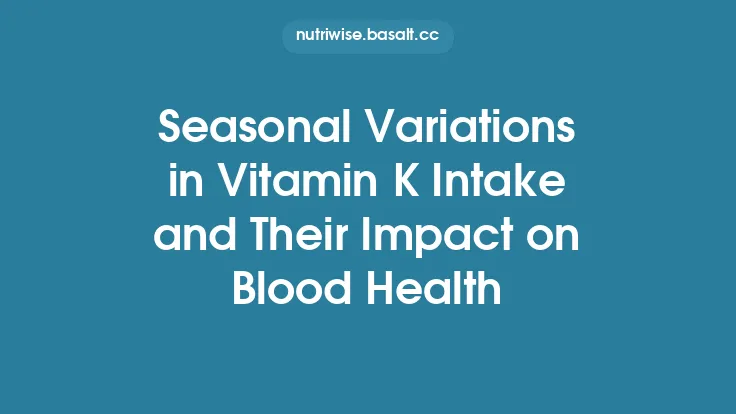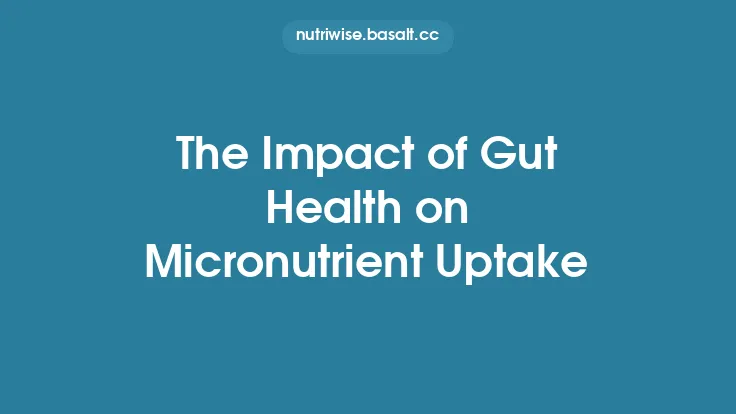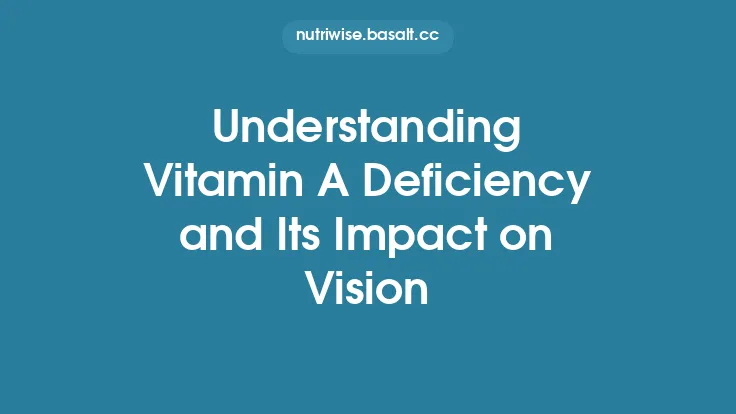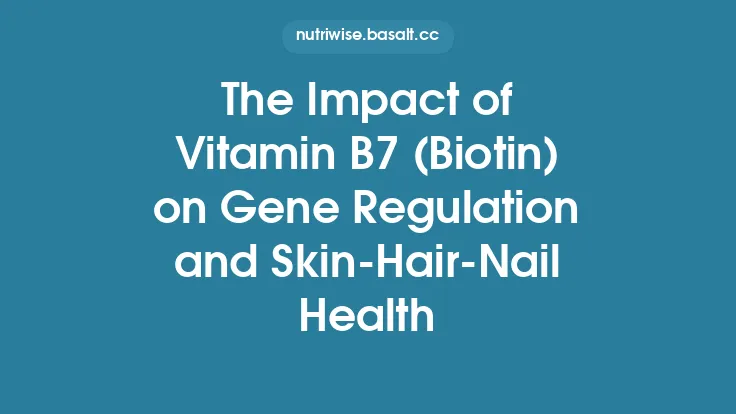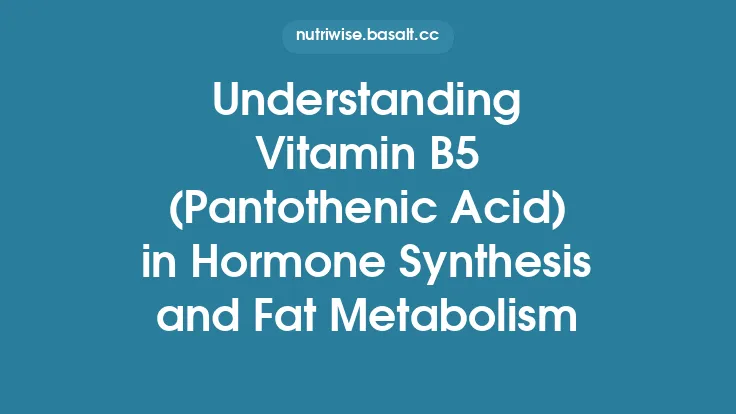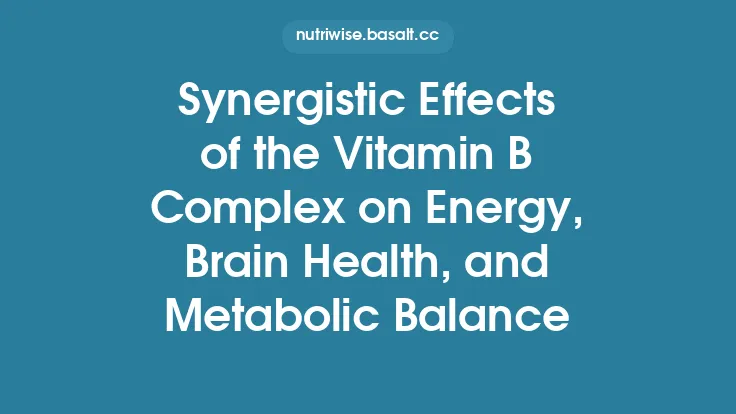The absorption, transport, and tissue distribution of the fat‑soluble vitamins (A, D, E, K) are tightly coordinated processes that hinge on the interplay between dietary lipids, bile‑derived surfactants, specialized carrier proteins, and lipoprotein pathways. Because these vitamins share a reliance on lipid‑based vehicles, any perturbation in the mechanisms that move them from the gut lumen to target cells can markedly influence overall micronutrient status. Understanding these mechanisms is essential for clinicians, nutrition scientists, and public‑health professionals who aim to prevent deficiencies, manage excesses, and design interventions that respect the unique biology of each vitamin.
Overview of Fat‑Soluble Vitamins and Their Biological Roles
| Vitamin | Primary Functions | Key Target Tissues | Representative Biomarkers |
|---|---|---|---|
| Vitamin A (retinol/retinal/retinoic acid) | Vision, epithelial integrity, immune modulation, gene transcription via nuclear receptors | Retina, skin, immune cells, gut epithelium | Serum retinol, retinol‑binding protein (RBP) |
| Vitamin D (cholecalciferol/ergocalciferol → 25‑OH‑D → 1,25‑(OH)₂‑D) | Calcium/phosphate homeostasis, bone remodeling, immune regulation, cell proliferation | Bone, kidney, intestine, immune cells | Serum 25‑hydroxy‑vitamin D |
| Vitamin E (α‑tocopherol and related tocopherols/tocotrienols) | Antioxidant protection of membranes, modulation of signal transduction, immune function | Cell membranes throughout the body | Serum α‑tocopherol |
| Vitamin K (phylloquinone, menaquinones) | γ‑carboxylation of clotting factors, bone matrix protein activation, vascular health | Liver, bone, vasculature | Serum phylloquinone, under‑carboxylated osteocalcin |
Although each vitamin has distinct physiological endpoints, they converge on a common set of transport and storage pathways that are dictated by their lipophilicity.
Digestion and Micelle Formation
- Emulsification by Bile Salts
- Bile salts (e.g., taurocholate, glycocholate) lower interfacial tension, dispersing dietary lipids into submicron droplets.
- The critical micellar concentration (CMC) of bile salts is modulated by the presence of phospholipids (mainly phosphatidylcholine) and cholesterol, which together create a mixed micelle capable of solubilizing hydrophobic molecules.
- Incorporation of Fat‑Soluble Vitamins
- Vitamin A (as retinyl esters), vitamin D₃ (cholecalciferol), vitamin E (α‑tocopherol), and vitamin K₁ (phylloquinone) partition into the core of mixed micelles.
- The efficiency of micellar incorporation is proportional to dietary fat content; a minimum of ~3–5 g of fat per meal is typically required to achieve >80 % micellar solubilization.
- Enzymatic Hydrolysis
- Pancreatic lipase, aided by colipase, hydrolyzes triglycerides, releasing free fatty acids and monoacylglycerols.
- For vitamin A, pancreatic cholesterol esterase hydrolyzes retinyl esters to free retinol, which is more readily absorbed.
- Vitamin D₃, already in a free form, does not require hydrolysis, whereas vitamin E and K are also absorbed as free molecules.
Enterocyte Uptake and Chylomicron Assembly
- Passive Diffusion vs. Carrier‑Mediated Transport
- The majority of fat‑soluble vitamins cross the apical brush‑border membrane by passive diffusion driven by the concentration gradient within micelles.
- Specific transporters augment this process:
- SR‑B1 (Scavenger Receptor Class B Type 1) facilitates uptake of vitamin E and vitamin K.
- NPC1L1 (Niemann‑Pick C1‑Like 1), while primarily known for cholesterol, also contributes to vitamin D absorption.
- Intracellular Esterification and Chylomicron Packaging
- Within enterocytes, retinol is re‑esterified by LRAT (lecithin‑retinol acyltransferase) to retinyl esters, which are then incorporated into nascent chylomicrons.
- Vitamin D₃ is bound to vitamin D‑binding protein (DBP) intracellularly before being packaged.
- α‑Tocopherol is preferentially incorporated into chylomicrons via the α‑tocopherol transfer protein (α‑TTP), which discriminates against other tocopherol isoforms.
- Vitamin K₁ is similarly packaged, often in association with phospholipids derived from the enterocyte membrane.
- Secretion into the Lymphatic System
- Mature chylomicrons (diameter 75–1200 nm) are exocytosed from the basolateral membrane and enter the lacteals of the intestinal villi.
- The low density of chylomicrons prevents immediate entry into the portal circulation, allowing a delayed, sustained release of fat‑soluble vitamins into systemic circulation.
Lymphatic Transport and Systemic Distribution
- Chylomicron Remnants
- As chylomicrons traverse the lymphatics and enter the bloodstream via the thoracic duct, lipoprotein lipase (LPL) hydrolyzes triglycerides, generating chylomicron remnants enriched in fat‑soluble vitamins.
- These remnants are rapidly cleared by hepatic LDL receptors (LDLR) and LDLR‑related protein (LRP1), delivering the vitamin cargo to the liver.
- Hepatic Processing
- The liver acts as a central hub:
- Vitamin A is stored as retinyl esters in hepatic stellate cells; a regulated pool of retinol is bound to RBP4 for export.
- Vitamin D is hydroxylated to 25‑hydroxy‑vitamin D (calcidiol) by CYP2R1 and bound to DBP for transport.
- Vitamin E is preferentially retained as α‑tocopherol via α‑TTP, while excess tocopherols are catabolized.
- Vitamin K is incorporated into γ‑carboxylase substrates and also secreted in bile for enterohepatic recycling.
- Redistribution via Plasma Lipoproteins
- After hepatic secretion, vitamins are redistributed on VLDL, LDL, and HDL particles:
- VLDL carries the bulk of vitamin E and vitamin K to peripheral tissues.
- LDL is a major carrier of vitamin A and vitamin D metabolites.
- HDL facilitates reverse transport, especially for vitamin E, and delivers vitamin K to the endothelium.
Cellular Uptake Mechanisms and Intracellular Binding Proteins
| Vitamin | Primary Cellular Receptor/Transporter | Intracellular Binding Protein | Functional Outcome |
|---|---|---|---|
| A (retinol) | STRA6 (Stimulated by Retinoic Acid 6) for retinol uptake; LDLR for retinyl ester delivery | CRBP‑I (Cellular Retinol‑Binding Protein I) | Retinol is oxidized to retinaldehyde → retinoic acid, driving gene transcription via RAR/RXR |
| D (calcidiol/1,25‑(OH)₂‑D) | LDLR and megalin/cubilin complex in renal proximal tubules; VDR‑mediated uptake in target cells | DBP (Vitamin D‑Binding Protein) and VDR (Vitamin D Receptor) | 1,25‑(OH)₂‑D binds VDR, modulating calcium‑phosphate homeostasis and immune genes |
| E (α‑tocopherol) | SR‑B1, CD36, and lipoprotein receptors (LDLR, LRP1) | α‑TTP (α‑Tocopherol Transfer Protein) and cytosolic tocopherol‑associated protein (TAP) | Antioxidant protection of membranes; modulation of signaling pathways |
| K (phylloquinone, menaquinones) | LDLR, SR‑B1, and possibly SLC46A1 (proton‑coupled folate transporter) | No dedicated cytosolic binding protein; vitamin K is directly utilized by γ‑glutamyl carboxylase | γ‑Carboxylation of clotting factors and osteocalcin |
The specificity of these receptors and binding proteins determines tissue selectivity. For instance, the high expression of STRA6 in the retina explains the eye’s vulnerability to vitamin A deficiency, while the liver‑centric expression of α‑TTP underlies the tight regulation of plasma α‑tocopherol concentrations.
Storage and Mobilization in Tissues
- Adipose Tissue
- All four fat‑soluble vitamins can be sequestered in triglyceride‑rich adipocytes.
- Vitamin E is the most abundant, serving as a long‑term antioxidant reservoir.
- Mobilization occurs during lipolysis, mediated by hormone‑sensitive lipase (HSL) and adipose triglyceride lipase (ATGL), releasing vitamins bound to fatty acids.
- Hepatic Stores
- Vitamin A: Stored as retinyl esters in hepatic stellate cells; mobilized via RBP4 under the control of retinoic acid feedback loops.
- Vitamin D: The liver does not store large amounts of the active hormone but maintains a sizable pool of 25‑hydroxy‑vitamin D bound to DBP.
- Vitamin E: Hepatic α‑TTP ensures that only α‑tocopherol is secreted, while other isoforms are catabolized to carboxyethylhydroxychromans (CEHCs).
- Vitamin K: Limited hepatic storage; rapid recycling via the enterohepatic circulation maintains status.
- Enterohepatic Recirculation
- Bile secretion re‑delivers vitamin K and a fraction of vitamin E to the intestinal lumen, where they can be re‑absorbed.
- Disruption of bile flow (e.g., cholestasis) markedly reduces the bioavailability of all fat‑soluble vitamins, underscoring the importance of intact biliary function.
Genetic and Physiological Factors Influencing Transport Efficiency
| Factor | Effect on Transport | Example |
|---|---|---|
| Polymorphisms in RBP4 | Altered retinol binding and plasma half‑life | RBP4‑Gly93Ser associated with reduced serum retinol |
| Mutations in α‑TTP (TTPA gene) | Familial isolated vitamin E deficiency (AVED) | Leads to severe neurological deficits despite adequate intake |
| Variations in CYP2R1 | Impaired 25‑hydroxylation of vitamin D | Contributes to hereditary vitamin D deficiency |
| Obesity | Expanded adipose sequestration, lower circulating levels | Dilution effect reduces bioavailability of vitamin E |
| Liver disease (cirrhosis, NAFLD) | Diminished chylomicron remnant clearance, reduced storage capacity | Leads to concurrent deficiencies of vitamins A, D, E, K |
| Age‑related decline in bile acid synthesis | Reduced micellar solubilization, especially for vitamin K | Contributes to higher deficiency risk in the elderly |
Understanding these modifiers helps clinicians interpret laboratory values and tailor supplementation strategies.
Clinical Implications for Micronutrient Status
- Deficiency Syndromes
- Vitamin A: Night blindness, xerophthalmia, impaired immunity.
- Vitamin D: Rickets/osteomalacia, secondary hyperparathyroidism, increased infection risk.
- Vitamin E: Neuromuscular degeneration, hemolytic anemia in severe deficiency.
- Vitamin K: Coagulopathy, osteopenia, vascular calcification.
- Excess and Toxicity
- Hypervitaminosis A (hepatic toxicity, teratogenicity) often results from chronic high‑dose supplementation that overwhelms hepatic storage.
- Vitamin D toxicity (hypercalcemia) is rare but can occur with megadoses that bypass normal regulatory feedback.
- Vitamin E excess may interfere with vitamin K–dependent clotting, though clinically significant interactions are uncommon.
- Impact of Impaired Transport
- Cystic fibrosis: Defective pancreatic enzyme secretion reduces micelle formation, leading to multivitamin deficiencies.
- Bariatric surgery: Altered anatomy diminishes bile acid exposure and fat absorption, necessitating lifelong fat‑soluble vitamin supplementation.
- Cholestatic liver disease: Reduced bile flow compromises micellar solubilization, often requiring water‑soluble vitamin K analogs.
Strategies to Optimize Fat‑Soluble Vitamin Transport
- Dietary Fat Quality and Quantity
- Include 3–5 g of dietary fat per meal to maximize micellar incorporation.
- Prefer long‑chain triglycerides (LCTs) over medium‑chain triglycerides (MCTs) for efficient chylomicron formation.
- Enhancing Bile Acid Availability
- Use of bile acid sequestrant antagonists (e.g., cholestyramine) should be timed away from vitamin‑rich meals.
- In cholestasis, ursodeoxycholic acid therapy can improve micelle formation and vitamin absorption.
- Targeted Supplement Formulations
- Emulsified or liposomal preparations: Mimic natural micelles, improving bioavailability in malabsorption states.
- Water‑soluble vitamin K analogs (e.g., menadiol sodium diphosphate) for patients with severe cholestasis.
- High‑bioavailability vitamin D3 (calcifediol) bypasses hepatic 25‑hydroxylation, useful in liver disease.
- Monitoring and Individualization
- Periodic measurement of serum retinol, 25‑hydroxy‑vitamin D, α‑tocopherol, and phylloquinone (or under‑carboxylated osteocalcin) guides dosing.
- Adjust supplementation based on body mass index, liver function tests, and presence of genetic variants affecting transport proteins.
Future Directions in Research
- Nanoparticle Delivery Systems: Engineering of biodegradable polymeric nanoparticles that co‑encapsulate fat‑soluble vitamins with bile‑acid mimetics could circumvent traditional absorption barriers.
- Omics‑Driven Personalization: Integration of genomics (e.g., TTPA, RBP4, CYP2R1 variants) with metabolomics to predict individual transport efficiency and tailor nutrient recommendations.
- Microbiome Interactions: While not a primary focus of this article, emerging data suggest gut microbes can modify vitamin K forms, influencing systemic status; delineating these pathways may refine supplementation strategies.
- Imaging of Vitamin Trafficking: Development of PET tracers labeled with ^11C‑retinol or ^18F‑vitamin D analogs will enable real‑time visualization of tissue uptake and storage, offering insights into disease‑related transport defects.
Continued interdisciplinary collaboration among nutrition scientists, gastroenterologists, hepatologists, and molecular biologists will be essential to translate these advances into practical guidelines that safeguard micronutrient health across the lifespan.
